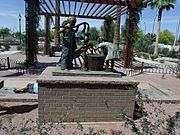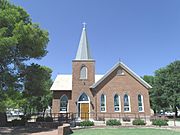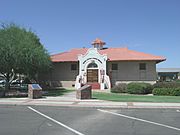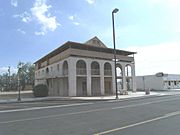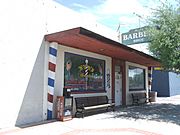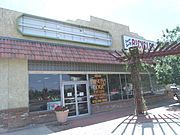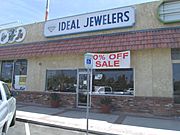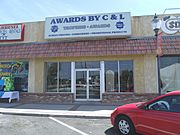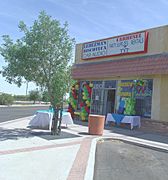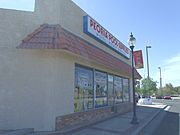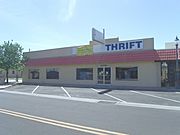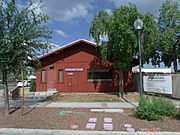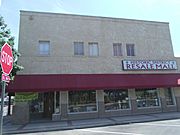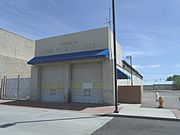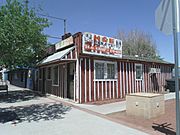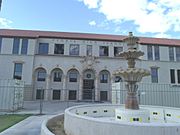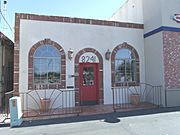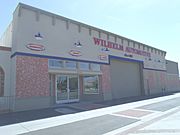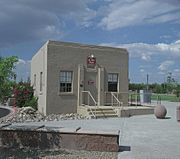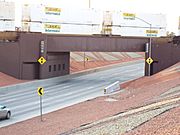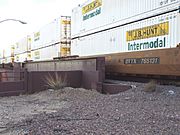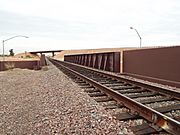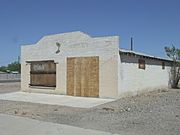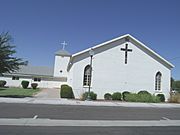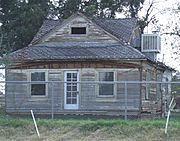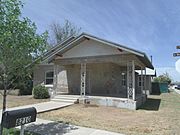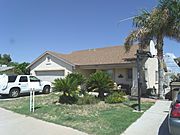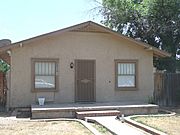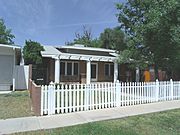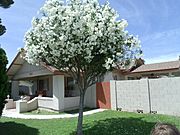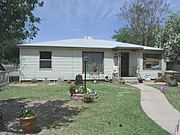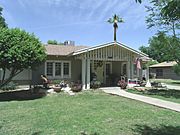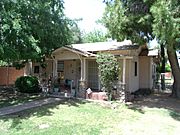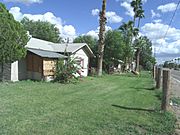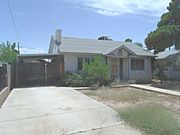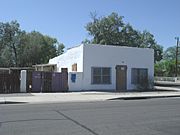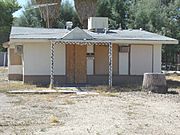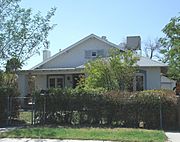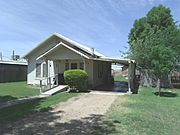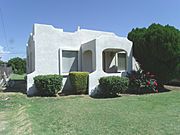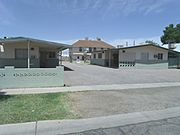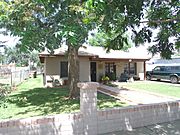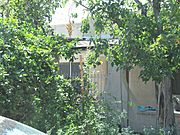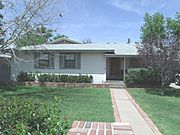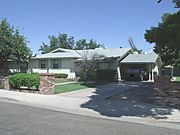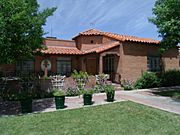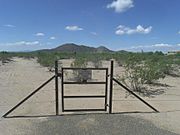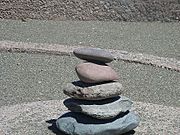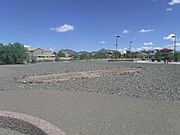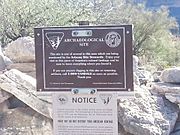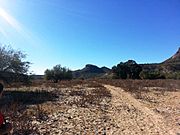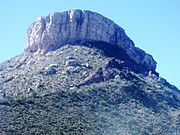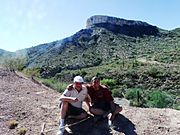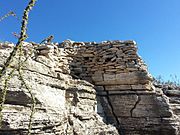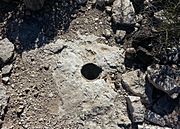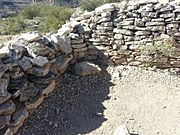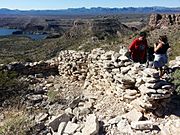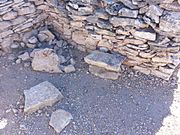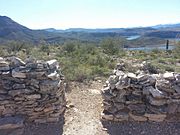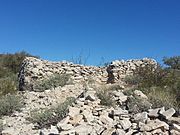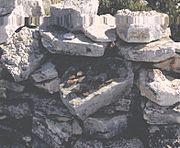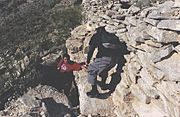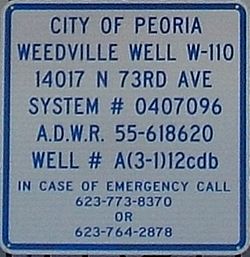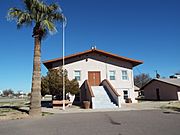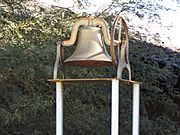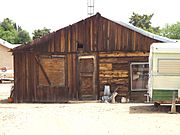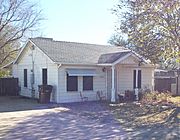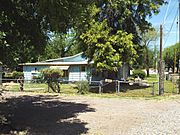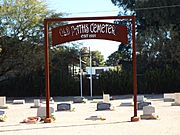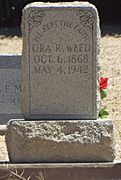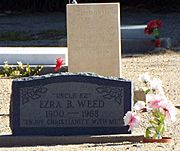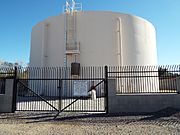List of historic properties in Peoria, Arizona facts for kids
Quick facts for kids
List of historic properties
in Peoria, Arizona |
|
|---|---|
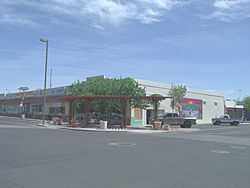
Old Town Peoria as seen from an intersection between Washington St. and 83rd. Ave.
|
|
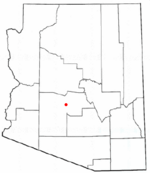
Location in Maricopa County and the state of Arizona
|
Welcome to a special tour of Peoria, Arizona's past! This article shows you some of the oldest and most important buildings and places in Peoria. These spots are so special that they're listed on the National Register of Historic Places or Peoria's own Historic Places list.
You'll see photos and learn about old buildings, homes, and even ancient ruins. We'll explore a village built by the Hohokam people long ago. Plus, we'll visit historic spots from a small community called Weedville. Get ready to discover Peoria's amazing history!
Contents
Peoria's Story: A Quick Look
Peoria is a city in Arizona, located in Maricopa and Yavapai counties. It started as a farming town in the late 1880s. Farmers from Peoria, Illinois moved here to settle the land.
A young engineer named William John Murphy helped them. He had just finished building part of a railway. In 1885, he also completed the Arizona Canal, which brought water to the area.

The new railway was a big help for the town. A small depot was built in 1895. Farmers could now ship their crops and cattle by train. People in Peoria could also get goods from other places.
In 1917, a big fire destroyed most of downtown Peoria. After that, people started building with stronger materials. Peoria officially became a city in 1954.
The Peoria Arizona Historical Society started in 1990. Their main goal is to save old buildings and items from Peoria's past. Their office and museum are in the historic Peoria Central School building. The society helps the city find and protect historic places.
Protecting Peoria's Past
The Peoria Historical Society works hard to save old buildings. However, they can't stop owners from tearing down historic properties. Even if a building is on a historic list, its owner can still get permission to demolish it.
The city of Peoria has rules for historic buildings. If someone wants to build or change a historic property, they need approval. This helps make sure changes fit the building's history.
But sometimes, old buildings are torn down anyway. Some owners can't afford to fix them up. Residents worry that the city isn't doing enough to save these historic homes. For example, the old town water tower from the 1890s was removed in 1936.
The Edwards Hotel, built in 1918, was Peoria's first hotel. It was almost torn down several times. Even though a new owner wanted to save it, the hotel was sadly demolished in 2021.
Historic Buildings and Places
Here are some of the historic buildings and important places in Peoria and nearby areas.
- 1889 Peoria Town Well – This well provided water for everyone. It's now in Osuna Park at Grand Avenue and Washington Street.
- Peoria Presbyterian Church – Built in 1899, this is the oldest building in original Peoria. It's at 10236 83rd Ave. (NRHP)
- Peoria Central School – This two-room school was built in 1906. Today, it's home to the Peoria Arizona Historical Society Museum. You can find it at 10304 N. 83rd Ave. (NRHP)
- Edwards Hotel – Built in 1918, this was Peoria's first hotel. It was located on Washington St. Sadly, it was torn down in 2021.
- Lazy J. Café – This building from 1918 is at 10455 N. 83rd Ave. It used to be the Lazy J. Café and now houses Bud's Barber Shop.
- Saliba's Pay 'n Takit/Park & Shop – Built in 1918 at 8295 W. Washington St. This was Peoria's first supermarket.
- Arizona Bank – This building, constructed in 1918 at 8291 W. Washington St., once housed the Arizona Bank. It still has its original sign.
- Peoria's Post Office – Peoria's first post office was in this building at 8273 & 8277 Washington St. It was built in 1918.
- Peoria-Wood's Pharmacy – Built in 1918 at 8271 W. Washington St., this was Wood's Pharmacy. One of its owners, Charles Vickery, also served as Mayor of Peoria.
- Thurton's Insurance – This 1918 building at 8265 W. Grand Ave. was home to Thurston's Insurance and Real Estate Company.
- Kosier's Hardware – Built in 1918 at 10440 N. 83rd Ave., this store was owned by the well-known Kosier family.
- Peoria Women's Club – Built in 1919, this building was used for movies before a theater was built. It's at 10351 84th Ave. (PRHP)
- Peoria Central School additions – Three more one-room school buildings were added to the Peoria Central School in the 1920s. (NRHP)
- Mabel Hood Building – Built in 1920, this building is at the corner of Washington St. and 83rd Ave. (PRHP)
- Paramount Theater – This building at 8307 W. Washington St. was built in 1920. It was first the Paramount Theater, then the Peoria Theater. After a fire, it became Fire Station #1 in 1954.
- La Tapitia Café – This building was built in 1920 and is at 10411 N. 83rd Ave.
- Peoria High School – The historic Peoria High School was built in 1922 at 11200 N 83rd Ave. It's the oldest high school in the Peoria Unified School District.
- Peoria Masonic Lodge 31 – This building, home to the Peoria Masonic Lodge #31, was built in 1922 at 10202 N. 83rd Ave.
- Wilhelm's Garage offices – The offices of Wilhelm's Garage were built in 1928 at 8241 W. Grand Ave. A big fire in 1917 started near this spot.
- Wilhelm Automotive – Established in 1929, Wilhelm Automotive is one of Arizona's oldest car companies. (PRHP)
- Peoria Jail House – Built in 1939, this building also hosted City Council meetings. It's now a public museum run by the Peoria Arizona Historical Society at 8322 W. Washington St. (PRHP)
- Peoria Underpass – Built around 1930, this underpass is at Grand and Olive Aves. It helps the Burlington Northern Santa Fe (BNSF) railroad system. It's considered a historic bridge.
- Quick Stop Groceries – This store was built in 1940 at 8484 Madison St. It's on the Peoria Register of Historic Places.
- Peoria Nazarene Church – Built in 1947 at 10440 N. 84th Ave., it was later sold and is now the "Greek Orthodox Church." It's also on the Peoria Register of Historic Places.
- Historic buildings in Old Town Peoria and the historic Peoria Underpass
(NRHP = National Register of Historic Places)
(PRHP=Peoria Register of Historic Places-listed)
Historic Houses
Here are some of the old houses in Peoria and its surrounding areas. Many of these homes belonged to important people in Peoria's early days.
- 1880s House – One of the oldest houses in Peoria, located on Northern Ave.
- Another 1880s House – Also on Northern Ave., showing early Peoria homes.
- Kosier House – Built in 1912 at 8210 W. Madison St. This bungalow was owned by the Kosier family, who ran Kosier's Hardware Store.
- Castillo House – Built in 1915 at 8180 Monroe St. It's on the Peoria Register of Historic Places.
- Gillis House – Built in 1918 at 8241 W. Madison St. It was owned by Edna Gillis, a local school teacher.
- Mason House – Built in 1919 at 8246 W. Madison St. The Wilhelm family, who owned Wilhelm's Garage, lived here.
- Sosnoskie House – Built in 1905 at 8210 W. Monroe St. This is the oldest home still standing in Old Peoria Townsite.
- Vickery/Belarde House – Built in 1920 at 8190 W. Monroe St. Charles Vickery, who owned Woods Pharmacy and was Mayor, first owned this home.
- Edmiston House – Built in 1920 at 10275 N. 82nd Ave. This brick bungalow is one of the few original brick homes left.
- Latham/Meeker House – Built in 1920 at 8270 W. Madison St. It belonged to families involved in the cotton business.
- Deatsch House – Built in 1920 at 8238 & 8240 W. Madison St. This was home to the Deatsch Brothers, who owned a hardware store.
- Shanty Houses – A row of houses from the 1920s on Northern Ave. These show how some people lived back then.
- C.A. Robinson House – Built in 1922 at 8211 W. Madison St. This craftsman-style house belonged to a well-known businessman and his wife.
- Coor House – Built in 1923 at 8255 W. Madison St. This house was ordered from a catalog and shipped by train! Pat Coor, Peoria's first barber, lived here.
- Meyer House – Built in 1925 at 8491 Madison St. It's on the Peoria Register of Historic Places.
- Peddicord House – Built in 1925 at 8453 Washington St. It's on the Peoria Register of Historic Places.
- Lebarion House – Built in 1929 at 8415 Madison St. It's on the Peoria Register of Historic Places.
- Roach House – Built in 1929 at 8276 W. Madison St. Bill Roach, who lived here, was the city's "waterman," making sure water meters worked.
- Vazquez House – Built in 1930 at 8344 Monroe St. It's on the Peoria Register of Historic Places.
- Turner Apartments – Built in 1935 at 8280 & 8286 W. Madison St. The Turner family lived upstairs and ran a carpentry business downstairs.
- Sullivan House – Built in 1936 at 8254 W. Madison St. Mr. Sullivan, a railway agent, owned this home.
- McCoy House – Built in 1938 at 8433 Jefferson St. It's on the Peoria Register of Historic Places.
- Lopez House – Built in 1947 at 8290 W. Monroe St. Several Peoria school teachers lived in this home.
- Camacho House – Built in 1947 at 8238 Monroe St. It's on the Peoria Register of Historic Places.
- Saliba House – Built in 1948 at 8276 W. Monroe St. This home belonged to the Saliba family, who owned the local grocery stores.
- Historic houses in Peoria's Old Townsite
(PRHP=Peoria Register of Historic Places-listed)
Palo Verde Ruins: An Ancient Village
The Palo Verde Ruin was once a large village for the Hohokam people. It's the second Peoria landmark to be listed on the National Register of Historic Places. This 20-acre area was home to the biggest Hohokam settlement along the New River.
- Palo Verde Ruin.
Indian Mesa: Hohokam Village Ruins
Indian Mesa is located in the Lake Pleasant Regional Park. On top of this mesa are the ruins of a very old Hohokam village. This site is watched over by the Arizona Site Stewards. The U.S. Bureau of Land Management considers it a very important archaeological site.
Experts believe that between the years AD 1000 and AD 1200, the Hohokam people built a community here. It might have housed 100 to 200 people. You can still see parts of their homes and even their ancient pottery.
- The ruins of a Hohokam village on top of Indian Mesa
-
Indian Mesa at Lake Pleasant Regional Park. On top of the Mesa are the ruins of a village built by the Hohokam about 1000 years ago.
-
Different views of the ruins of a village built by the Hohokam about 1000 years ago on top of Indian Mesa located at Lake Pleasant. This is part of the wall of the fort that surrounded the village. The holes in the wall are viewing holes so the defenders can view the only path to the top. There are several branches of an "Ocotillo" shrub in the foreground.
-
A posthole dug by the Hohokam inside their house. The Hohokam placed heavy mesquite or pine posts on them to support a roof.
Weedville: A Historic Community
Weedville, Arizona was a small community started in 1911. Reverend Ora Rush Weed, a Methodist minister, founded it. At the time, Weedville was outside Peoria's city limits. It's still an unincorporated area today, meaning it's managed by Maricopa County.
See also


